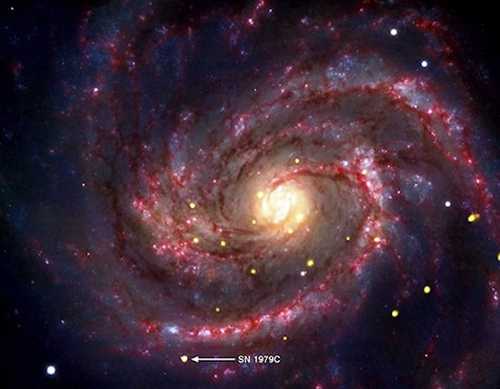
Astronomers using NASA's Chandra X-ray Observatory have found evidence of the youngest black hole known to exist in our cosmic neighborhood.
The 30-year-old object provides a unique opportunity to watch a black hole develop from infancy.
The black hole is a remnant of SN 1979C, a supernova in the galaxy M100 approximately 50 million light years from Earth.
Data from Chandra, NASA's Swift satellite, the European Space Agency's XMM-Newton and the German ROSAT observatory revealed a bright source of X-rays that has remained steady during observation from 1995 to 2007. This suggests the object is a black hole being fed either by material falling into it from the supernova or a binary companion.
“If our interpretation is correct, this is the nearest example where the birth of a black hole has been observed,” said Daniel Patnaude of the Harvard-Smithsonian Center for Astrophysics in Cambridge, Mass. who led the study.
Scientists think SN 1979C, first discovered by an amateur astronomer in 1979, formed when a star about 20 times more massive than the sun collapsed.
Many new black holes in the distant universe previously have been detected in the form of gamma-ray bursts (GRBs). However, SN 1979C is different. Not only is it closer, but also it belongs a class of supernovas unlikely to produce gamma-ray bursts.
According to theory, most new black holes are not announced by a bright GRB.
“This may be the first time the common way of making a black hole has been observed,” said co-author Abraham Loeb, also of the Harvard-Smithsonian Center for Astrophysics. “However, it is very difficult to detect this type of black hole birth because decades of X-ray observations are needed to make the case.”
The idea of a black hole with an observed age of only about 30 years is consistent with recent theoretical work.
In 2005, a theory was presented that the bright optical light of this supernova was powered by a jet from a black hole that was unable to penetrate the hydrogen envelope of the star to form a GRB. X-ray data from Chandra and the other observatories fit this theory very well.
Although the evidence points to a newly formed black hole in SN 1979C, another intriguing possibility exists: A young, rapidly spinning neutron star with a powerful wind of high energy particles could be responsible for the X-ray emission.
This would make the object in SN 1979C the youngest and brightest example of such a “pulsar wind nebula” and the youngest known neutron star.
The Crab pulsar, the best-known example of a bright pulsar wind nebula, is about 950 years old. More observations will either confirm or rule out this alternate explanation; for now, however, the black hole hypothesis appears to be more compelling.
For more information and images, visit the Chandra home page: http://chandra.nasa.gov .
Click here to see an animation of a supernova producing a black hole: www.nasa.gov/multimedia/videogallery/index.html?media_id=29520021 .
Dr. Tony Phillips works for the National Aeronautics and Space Administration.
Follow Lake County News on Twitter at http://twitter.com/LakeCoNews , on Facebook at http://www.facebook.com/pages/Lake-County-News/143156775604?ref=mf and on YouTube at http://www.youtube.com/user/LakeCoNews .